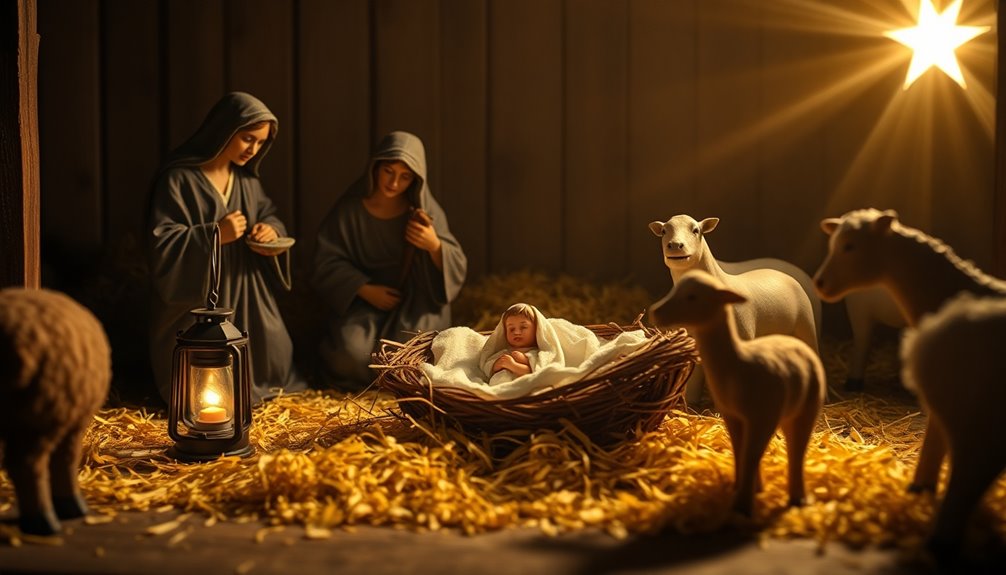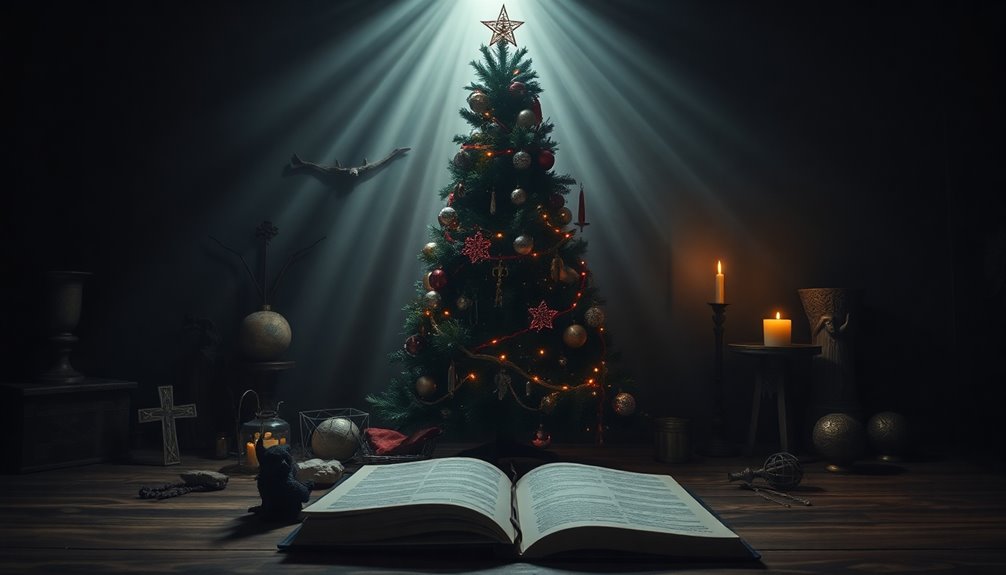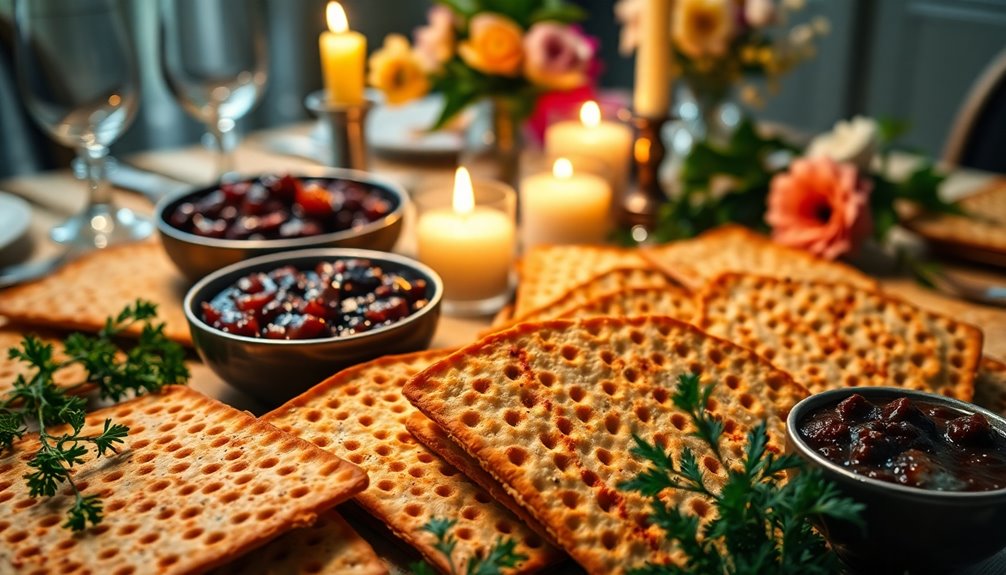Christmas celebrates the birth of Jesus Christ, initially recognized on December 25 in the 4th century. The holiday's name comes from "Christ's Mass," first used in 1038. Early Christians picked this date to offer a Christian alternative to existing pagan festivals like Saturnalia. Over time, traditions like evergreen decorations and communal feasting merged into the celebration. While some might link Christmas to pagan origins, it stands as a distinct Christian event rich in cultural significance. There's much more about how these traditions evolved and shaped today's celebrations, waiting for you to uncover.
Key Takeaways
- Christmas celebrates the birth of Jesus Christ, recognized on December 25 since the 4th century, blending Christian and pagan traditions.
- The term "Christmas" comes from "Christ's Mass," first recorded in 1038 as "Crīstesmæsse."
- Early Christians established December 25 to provide a Christian alternative to pagan festivals like Saturnalia and Sol Invictus.
- The first documented Christmas celebration occurred in 336 CE, marking the formal observance of the holiday.
- Christmas evolved over centuries, integrating various cultural customs while maintaining its significance as a Christian celebration.
Introduction

Christmas, celebrated by millions around the world, has its roots deeply embedded in early Christian traditions. This joyous celebration marks the birth of Jesus Christ, with December 25 officially recognized as the date for this event since the 4th century. The term "Christmas" itself comes from "Christ's Mass," first recorded as "Crīstesmæsse" in 1038, emphasizing its religious significance.
The origins of Christmas are intertwined with the early church's efforts to establish a distinct Christian holiday. Early Christians likely chose December 25 to coincide with and replace existing pagan festivals, such as Saturnalia and the Roman celebration of Sol Invictus. This strategic timing helped to promote the new faith while integrating familiar customs.
The first documented Christmas celebration dates back to 336 CE, showcasing that this holiday has been observed for nearly 1,700 years. Over time, the blending of pagan customs, such as the use of evergreens and communal feasting, contributed to the evolution of Christmas traditions we cherish today.
As you explore the holiday, you'll discover how these historical roots have shaped the way we celebrate Christmas in modern society.
Biblical Birth Narratives

When you look at the biblical birth narratives, you'll find the primary accounts in the Gospels of Matthew and Luke.
Each Gospel presents unique details, like the Magi's visit in Matthew and the angel's announcement to Mary in Luke.
These stories not only share the events of Jesus' birth but also connect to significant themes and prophecies throughout the Bible.
Primary Bible References
Exploring the primary biblical birth narratives reveals the distinct yet complementary accounts of Jesus' nativity found in the Gospels of Matthew and Luke.
The Gospel of Matthew emphasizes the virgin birth, detailing how Mary conceived through the Holy Spirit, fulfilling the prophecy from Isaiah 7:14. This account highlights the significance of Jesus' arrival, aligning with the anticipated date of Jesus' birth in Bethlehem.
In contrast, the Gospel of Luke offers a more pastoral perspective, detailing the circumstances surrounding Jesus' humble birth in a manger due to a crowded inn. Luke 2:1-20 narrates the census that brought Joseph and Mary to Bethlehem and describes how angels announced the good news to nearby shepherds, showcasing the accessibility of the Messiah.
Moreover, Matthew's narrative includes the visit of the Wise Men, who followed a star to honor the newborn king, presenting gifts of gold, frankincense, and myrrh (Matthew 2:1-12).
Together, these accounts not only celebrate the fulfillment of prophecies but also reveal the profound significance of Jesus' nativity, inviting you to reflect on the deeper meaning of Christmas.
Secondary Bible References
In addition to the primary accounts in Matthew and Luke, several secondary biblical references enrich our understanding of Jesus' birth. The New Testament provides insights into how early Christians viewed the significance of this event. For instance, the virgin birth, emphasized in both accounts, is crucial for understanding Jesus as the Messiah and Savior, a cornerstone of Christian belief.
You'll find that Matthew highlights the visit of the Magi and the fulfillment of Old Testament prophecies. This connection to prophecy adds depth to the celebration of Christmas, as it showcases God's plan unfolding through history.
Conversely, Luke focuses on the humble circumstances of Jesus' birth, including the angelic announcement to the shepherds, which underscores the accessibility of Jesus to all, not just the elite.
These narratives collectively affirm Jesus' importance within the Church and the broader Christian community. They provide a framework for the date of Christmas and its significance as a celebration of hope and salvation.
Pagan Winter Solstice Celebrations

Pagan winter solstice celebrations, rich in history and tradition, were a vibrant part of ancient cultures. One of the most notable was Saturnalia, held in ancient Rome from December 17 to 24. This festival honored the god Saturn and was marked by feasting, gift-giving, and merrymaking.
You'd find people exchanging presents and indulging in lavish banquets, creating a joyous atmosphere that transcended social hierarchies.
Another significant celebration was Sol Invictus, or the Unconquered Sun, observed on December 25. This festival symbolized the return of longer days and the sun's triumph over darkness.
Many pagan cultures lit bonfires and candles during this time, signifying hope and renewal.
As these pagan winter solstice celebrations evolved, elements like holly, ivy, and festive decorations began to blend into early Christian customs.
This melding of traditions laid the groundwork for the Christmas holiday we recognize today. By incorporating these ancient practices, the rich tapestry of winter celebrations was woven, connecting the past with the present and ensuring that the spirit of joy and togetherness lives on.
Cultural Significance of Christmas

Christmas has grown beyond its ancient roots to become a celebration that resonates with billions around the globe. Over 2 billion Christians celebrate this holiday, intertwining local cultural customs with traditional Christian practices.
You'll find that gift exchanges and festive feasting have become integral to modern Christmas celebrations, reflecting a blend of secular and religious elements. In many cultures, Christmas trees stand as central symbols, representing eternal life, while lights signify Jesus as the Light of the World.
Unique customs, like Las Posadas in Mexico or piñata celebrations, highlight how different communities have shaped the holiday, offering a rich tapestry that defines its cultural significance.
However, the commercialization of Christmas has dramatically influenced consumer culture, transforming it into a key economic event, especially for the retail sector. As you navigate the holiday season, you might notice how this commercialization often overshadows the original religious roots, shifting focus towards consumerism.
Yet, amidst this, the spirit of Christmas remains alive, as families and communities come together to celebrate, share joy, and honor both their traditions and the essence of the holiday.
Misunderstandings About Christmas Origins

You might've heard that Christmas has its roots in pagan celebrations, but that's a common misconception.
While some customs overlap, Christmas is primarily about celebrating the birth of Jesus Christ.
Let's explore the historical accuracy of these claims and clarify what Christmas really represents.
Debunk Christmas Pagan Connections
Misunderstandings about Christmas origins often link the holiday to ancient pagan rituals, but this connection is more myth than fact. Christmas began as a celebration of Jesus' birth, established by early Christians in the 4th century. Historical documents indicate that the recognition of December 25 as the birth date of Christ happened long before any significant pagan feasts were associated with that date.
While it's true that some customs, like feasting and merrymaking, may share similarities with pagan rituals, the holidays themselves were distinct with different meanings. Early Christian clergy chose December 25 to offer a Christian alternative to existing pagan celebrations, but there's no evidence of overlapping practices.
Instead, the integration of symbols, such as holly and candles, reflects a reinterpretation within a Christian context rather than pagan worship.
Ultimately, the roots of Christmas are firmly planted in Christian tradition, emphasizing the celebration of Jesus' birth. By embracing this understanding, you can appreciate the holiday's significance without the confusion surrounding its supposed pagan connections.
Recognizing Christmas for what it truly is—a Christian celebration—helps clarify its origins and purpose.
Skepticism About Historical Accuracy
Skepticism about the historical accuracy of Christmas origins often arises from the persistence of myths linking the holiday to pagan traditions. Many people conflate Christmas with festivals like Saturnalia and Sol Invictus, despite evidence showing that Christmas became a distinct Christian celebration established in the fourth century. The early church chose December 25 not to mirror pagan festivities but to offer a Christian alternative during the winter solstice, reflecting their intent to adapt existing traditions.
While some elements of Christmas, such as bells and holly, have roots in ancient pagan customs, their incorporation into Christmas doesn't indicate a continuation of pagan worship. Instead, it highlights the holiday's complex evolution, shaped by various cultural influences over centuries.
The debate about Christmas's pagan origins often references Romans 14:5, which emphasizes personal conscience in observing specific days. This illustrates the diversity of Christian perspectives on the holiday.
Ongoing research challenges the oversimplified narrative that connects Christmas to pagan practices, revealing a richer history that celebrates its Christian roots while acknowledging the multifaceted influences that have shaped it. Additionally, the Law of Attraction principles suggest that the energy and intention behind celebrations can greatly influence their vibrational significance.
Charitable Giving Practices

When you think about the holidays, acts of kindness often come to mind, reflecting the true spirit of Christmas.
Local outreach initiatives, like food drives and toy donations, show how communities come together to support those in need.
This season of giving not only spreads cheer but also reinforces the values of compassion and generosity that Christmas embodies.
Acts of Kindness During Holidays
During the holiday season, many of us feel inspired to spread joy through acts of kindness and charitable giving. This time of year, the spirit of generosity shines bright, as families and individuals engage in donating food, clothing, and toys to those in need. Initiatives like Operation Christmas Child exemplify this, providing millions of shoebox gifts to children worldwide each year.
Charitable giving peaks in December, with about 30% of annual donations happening during the Christmas season, underscoring its significance for non-profit organizations and community service efforts. The joy of giving is further enhanced by practices like Secret Santa, where anonymous gifts foster kindness and promote community support.
Research shows that participating in these acts of kindness not only uplifts those receiving help but also boosts your well-being and community morale. By sharing your resources and time, you create a ripple effect of positivity that extends beyond material gifts.
Embracing this spirit of generosity during the holidays can transform your experience, making the Christmas season not just about receiving, but about giving and connecting with others in meaningful ways.
Local Outreach Initiatives
Local outreach initiatives play a crucial role in fostering community spirit and providing support to families in need during the Christmas season. Charitable giving, rooted in the Christian tradition of almsgiving, reflects the generosity that defines this holiday. Many community organizations and churches organize food drives, toy collections, and other events aimed at helping those less fortunate.
During December, charitable donations in the United States see a significant spike, with around 30% of annual giving occurring this month. Programs like "Adopt a Family" allow you and local businesses to sponsor families in need, ensuring they receive essential items and gifts for a more joyful Christmas.
Volunteering your time at soup kitchens and shelters also contributes to this spirit of giving back. By engaging in these local outreach initiatives, you not only help families in need but also strengthen the bonds within your community.
Whether it's through donating, organizing events, or simply lending a hand, your involvement makes a meaningful impact. Embracing these charitable practices enriches the Christmas season for everyone, reminding us of the true essence of generosity and compassion.
Festive Global Celebrations

Celebrating Christmas around the globe reveals a rich tapestry of traditions that blend cultural heritage with religious significance. You'll find unique customs in different regions, each adding its flavor to this festive holiday.
While many Christians celebrate Christmas on December 25, Eastern Orthodox churches observe it on January 7, reflecting their own traditions and calendars.
In Mexico, for example, locals celebrate with Las Posadas, reenacting Mary and Joseph's search for lodging. This festive tradition beautifully showcases the intertwining of cultural and religious elements.
Over in Brazil, the holiday comes alive with fireworks, beach picnics, and the "Ceia de Natal," a vibrant dinner featuring turkey and seasonal fruits.
If you venture to India, you'll notice that Christmas is marked by mango or bamboo trees, adorned with mango leaves and colorful paper stars, a testament to local customs.
Meanwhile, in Japan, Christmas takes on a different vibe, leaning more toward a cultural celebration with festive decorations and popular songs, often finished off with a romantic twist involving Christmas cakes.
These global celebrations highlight the diverse ways people celebrate Christmas, each tradition contributing to the holiday's rich legacy.
Additional Resources

To deepen your understanding of Christmas and its origins, a wealth of resources is available for exploration. One notable text is "The Case for Christmas" by Lee Strobel, which investigates the origins and significance of Christmas, linking it to key historical and theological discussions.
You can also check out Logos Bible Software, which provides a variety of biblical and scholarly resources that delve into the historical context of Christmas celebrations.
In the early fourth century, Christian writers and Church Fathers began celebrating Christmas on December 25, aiming to establish a distinct holiday amidst existing pagan festivities.
Various articles detail how Christmas traditions evolved over the centuries, illustrating the blending of pagan customs with Christian practices. These resources highlight the cultural significance of Christmas, encouraging you to challenge common misconceptions about its origins. Additionally, understanding the importance of cultural influences can enhance your appreciation of how different societies have shaped Christmas traditions over time.
Frequently Asked Questions
What Is the Actual Origin of Christmas?
You might be curious about the actual origin of Christmas. It started as a simple celebration of winter solstice and evolved over centuries.
Early Christians adopted December 25 to coincide with existing pagan festivals, aiming to provide a Christian alternative.
As time passed, Christmas transformed into a blend of traditions, incorporating customs like gift-giving and decorating trees.
Today, it stands as a multifaceted holiday that reflects both religious significance and cultural practices worldwide.
What Is the Real Story of Christmas Day?
The real story of Christmas Day centers around the celebration of love, joy, and togetherness.
You gather with family and friends, sharing gifts and creating lasting memories. The holiday often includes traditions like decorating a tree, singing carols, and enjoying festive meals.
No matter your background, Christmas reflects a spirit of giving and compassion, reminding you to appreciate the people in your life and the blessings you have.
It's a time to cherish connections.
Why Was December 25TH Chosen as the Birthday of Jesus?
You might wonder why December 25th was chosen as Jesus' birthday. Early Christians linked this date with the winter solstice, celebrating the return of light.
They believed Jesus was conceived on March 25th, leading to a December birth. By the 4th century, this date gained acceptance, aligning with existing pagan festivities.
It allowed early Christians to promote their beliefs while replacing popular customs, creating a unique celebration that resonated with their faith and traditions.
Is the Celebration of Christmas Biblical?
The celebration of Christmas isn't explicitly biblical, as the Bible doesn't specify a date for Jesus' birth.
Early Christians didn't initially emphasize this event, focusing more on Jesus' teachings.
However, many believers today see Christmas as a meaningful time to reflect on Jesus' incarnation and its significance.
Romans 14:5 suggests that observing certain days is a personal choice, so you can celebrate Christmas in a way that resonates with your faith.










